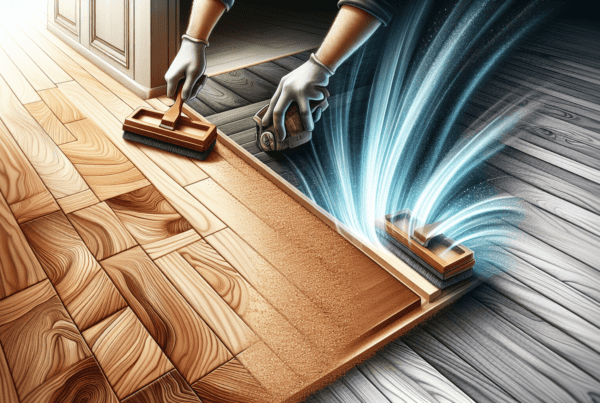In the heart of Wellington, the art of timber floor sanding and finishing has reached new heights, thanks to the adoption of advanced techniques that breathe life into even the most worn-out wooden floors. As enthusiasts of impeccable flooring, let’s explore how these innovative methods not only restore the natural beauty of timber but also ensure its longevity. From choosing the right sandpaper grit to the final glossy finish, every step is a testament to the craftsmanship that Wellington’s specialists pour into their work. Join us as we uncover the secrets behind achieving that perfect shine and durability in timber flooring.
Understanding Timber Floor Sanding & Finishing
Definition of Floor Sanding and Finishing
In our quest to maintain and rejuvenate our timber floors, we often turn to the processes of sanding and finishing. Sanding refers to the removal of the top surfaces of a wooden floor by abrasive materials, aiming to eliminate scratches, dents, and inconsistencies. Finishing, on the other hand, involves applying a protective layer that enhances the wood’s appearance and durability. Together, these processes can significantly improve the longevity and aesthetic appeal of our floors.
The Importance of Timber Floor Maintenance
For us, the maintenance of timber floors is not just about keeping them looking good. It also plays a crucial role in protecting the investment we have made in our homes. Well-maintained floors can significantly increase a property’s value and appeal. Regular sanding and finishing help to protect the wood from damage, wear, and tear, ensuring that our floors stand the test of time.
Types of Timber Floors Common in Wellington
In Wellington, we encounter a variety of timber floors ranging from native species like Rimu and Matai to exotic options like Oak and Bamboo. Each type has its unique characteristics and requires specific maintenance techniques. Understanding the specifics of our timber floors can significantly influence the approach to sanding and finishing, ensuring better protection and enhancement of the wood.
Preparation for Sanding and Finishing
Clearing the Work Area
Before we embark on the sanding and finishing journey, it’s crucial to clear the work area. Removing furniture, curtains, and other items ensures that we have unrestricted access to the floor. This preparation step minimizes the risk of damage to our belongings and streamlines the process.
Assessing the Timber Floor Condition
We always take the time to carefully assess the condition of our timber floors. Identifying issues like deep scratches, discolorations, or signs of rot early on can help us tailor the sanding strategy and choose the most appropriate finishes, resulting in a more effective restoration.
Choosing the Right Sanding Equipment
Selecting the correct sanding equipment is pivotal for us. The choice often depends on the floor’s condition, the type of timber, and the desired outcome. Investing in high-quality sanders that offer a range of grits allows us to achieve a smooth, even surface ready for finishing.
Safety Measures and Precautions
We prioritize our safety by donning protective gear such as dust masks, safety goggles, and ear protection. Ensuring good ventilation and being mindful of the equipment’s power are also critical precautions that protect us from potential hazards during the sanding and finishing processes.
Tools and Materials
Types of Sanding Machines
In our toolkit, we have various types of sanding machines including belt sanders, orbital sanders, and edge sanders. Each serves a specific purpose, from quickly removing the old finish to reaching the corners and edges that other sanders cannot access.
Selection of Sandpaper Grit
We meticulously select sandpaper grits, starting with coarse grades to remove the old finish and imperfections, gradually moving to finer grits for a smooth finish. Understanding how different grits affect the wood allows us to achieve the best surface for finishing.
Finishes for Timber Floors
Our choice of finishes includes oil-based, water-based, polyurethane, and natural oil finishes. Each has its advantages, from durability to environmental friendliness. We consider the usage of the room, the type of timber, and aesthetic preferences to select the most suitable finish.
Cleaning Supplies
Equally important are the cleaning supplies that help us keep the area dust-free and prepare the floor for finishing. Tack cloths, vacuum cleaners, and damp mops are some of the tools we rely on to ensure that no dust or debris compromises the quality of the finish.
The Sanding Process
Starting with Coarse Grits
We begin the sanding process with coarse grits to remove the old finish and any significant imperfections. This step is vital for leveling the floor and ensuring a uniform surface, laying the foundation for finer grits to further smooth the wood.
Progressing to Finer Grits
After the initial pass with coarse grits, we progress to finer grits. Each subsequent sanding aims to eliminate the scratches left by the previous grit, gradually refining the wood’s surface to prepare it perfectly for the finishing touches.
Dealing with Hard-to-Reach Areas
We pay special attention to hard-to-reach areas such as corners and edges. Using hand sanders and edge sanders, we ensure these spots receive the same level of care and preparation as the rest of the floor, resulting in a uniformly smooth surface.
Sanding Techniques for Different Timber Types
Given the variety of timber types in Wellington, we adapt our sanding techniques accordingly. Hardwoods like Oak require different approaches compared to softer woods like Pine. Understanding the characteristics of each type of timber guides us in choosing the right sanding techniques to achieve the best results.
Dust Management and Cleanup
Preventing Dust Spread during Sanding
To minimize the spread of dust, we use sanding machines equipped with dust collection systems. We also seal off the work area as much as possible and ensure good ventilation to keep the air clean and prevent dust from settling on surfaces outside the immediate workspace.
Effective Vacuuming Strategies
After each sanding pass, we employ effective vacuuming strategies to remove the dust from the floor. By meticulously vacuuming before moving to the next grit, we ensure that no coarse particles remain that could scratch the floor during subsequent sanding stages.
Ensuring a Clean Working Environment
Keeping the work environment clean is essential for both our health and the quality of the finish. We regularly clean our equipment and the workspace, ensuring that the final application of the finish is free from any contaminants that could mar the surface.
Choosing the Right Finish
Types of Finishes: Oil vs. Water-Based
Our choice between oil-based and water-based finishes often depends on several factors, including the desired look, the drying time, and the environmental impact. Oil-based finishes offer a rich, warm look but have longer drying times and stronger odors. Water-based finishes dry more quickly and have a lower environmental impact, but might not impart the same depth of color.
Factors Influencing Finish Selection
When choosing a finish, we also consider the floor’s traffic level, maintenance requirements, and compatibility with the type of timber. High-traffic areas might benefit from a more durable and easily maintained finish like polyurethane, while living areas might do well with the natural beauty enhanced by oil finishes.
Environmental Considerations
In our decision-making process, we increasingly prioritize finishes with lower volatile organic compound (VOC) levels. Choosing more environmentally friendly options not only benefits our health but also aligns with our commitment to sustainability.
Application of Finish
Preparing the Floor for Finishing
Before applying the finish, we ensure the floor is impeccably clean and free of dust. Any imperfections at this stage could become permanently visible once the finish is applied, so we take extra care in the preparation phase.
Techniques for Even Finish Application
We apply the finish using brushes or rollers designed for the specific type of finish, working in manageable sections to maintain a wet edge. This method helps avoid overlap marks and ensures an even, consistent coat across the entire floor.
Dealing with Bubbles and Imperfections
Should bubbles or imperfections arise during the application, we address them promptly, often using a fine brush to smooth out the finish before it dries. This meticulous attention to detail ensures a flawless final appearance.
Drying Times and Conditions
We follow the manufacturer’s guidelines for drying times and conditions, which vary among different finishes. Ensuring adequate ventilation and avoiding walking on the floor until it’s fully cured are crucial steps to guarantee the finish sets correctly and lasts for years.
Aftercare and Maintenance
Routine Cleaning Recommendations
For ongoing care, we recommend routine cleaning with products specifically designed for timber floors. Avoiding harsh chemicals and excessive water helps protect the finish and the wood underneath, maintaining the floor’s beauty and durability.
Avoiding and Dealing with Scratches
To minimize scratches, we use protective pads under furniture and rugs in high-traffic areas. When scratches do occur, we assess whether a simple spot repair is feasible or if a more extensive re-sanding and finishing process is necessary.
When to Refinish Again
The lifespan of a finish varies depending on usage and maintenance, but we generally anticipate needing to refinish every 7-10 years. Signs like widespread dullness, deep scratches, or discoloration indicate that it’s time for us to consider refinishing our floors.
Troubleshooting Common Issues
Dealing with Uneven Sanding Marks
If we notice uneven sanding marks, it often means we need to revisit the area with the same or a slightly finer grit until the imperfections are removed. Achieving a uniformly smooth surface before moving on is crucial.
Fixing Discoloration After Finishing
Discoloration after finishing can result from a variety of issues, including moisture, uneven application, or using an incompatible finish. We might need to strip the affected area and reapply the finish, taking care to address the underlying cause.
Addressing Peeling and Chipping
Peeling and chipping of the finish are usually signs of adhesion issues, possibly due to improper floor preparation or applying the finish over contaminants. Stripping the problematic finish, thoroughly cleaning the surface, and reapplying the finish are the steps we take to correct these issues.
Finding a Professional in Wellington
Qualities of a Good Timber Floor Specialist
When we’re seeking a professional for our timber floor sanding and finishing needs in Wellington, we look for qualities such as experience, a good reputation, and a portfolio of completed projects. Professionals who offer detailed consultations and transparent quotes are also high on our list.
How to Choose the Right Service Provider
Choosing the right service provider involves researching and comparing different specialists based on their expertise, reviews, and quotes. We also consider their willingness to discuss our specific needs and offer customized solutions.
Understanding Quotes and Services Offered
Finally, understanding the details of the quotes and services offered allows us to make informed decisions. We look for clear breakdowns of costs, timelines, and the scope of work, ensuring there are no surprises during the process.
In our journey to maintain and enhance our timber floors in Wellington, attention to detail, proper preparation, and choosing the right professionals are key. By understanding and applying advanced timber floor sanding and finishing techniques, we ensure that our floors remain a beautiful and durable part of our homes for years to come.







